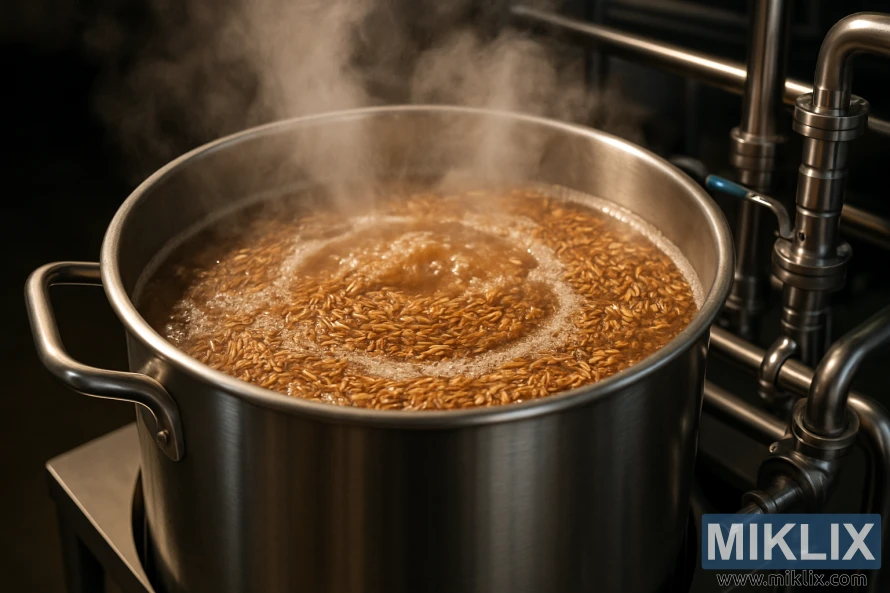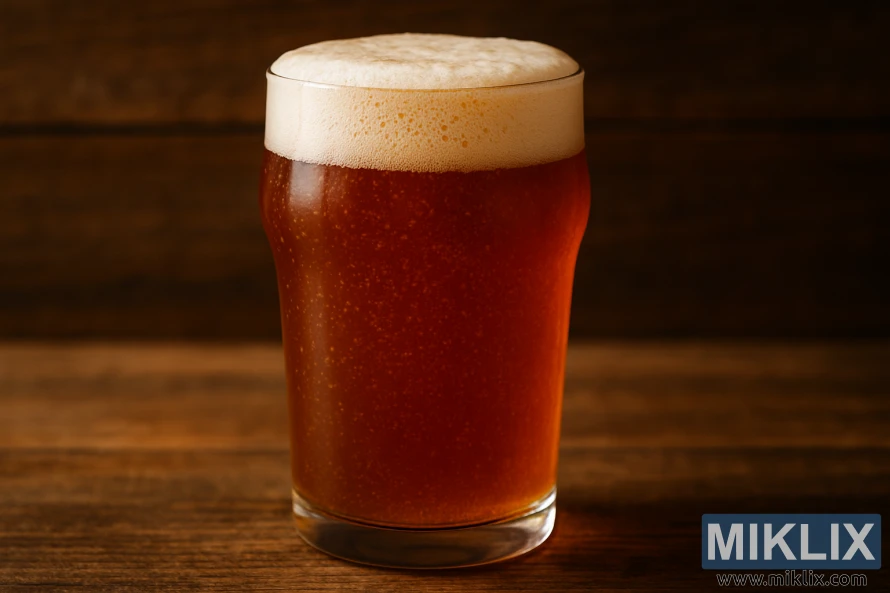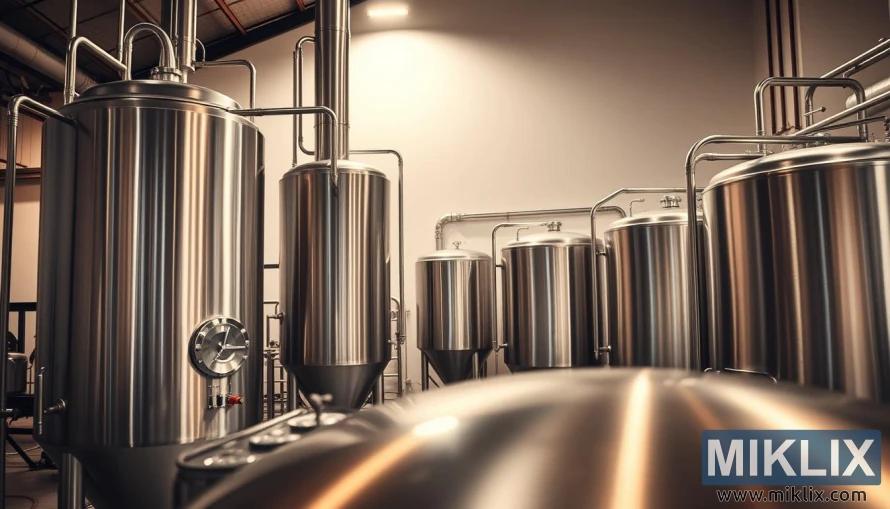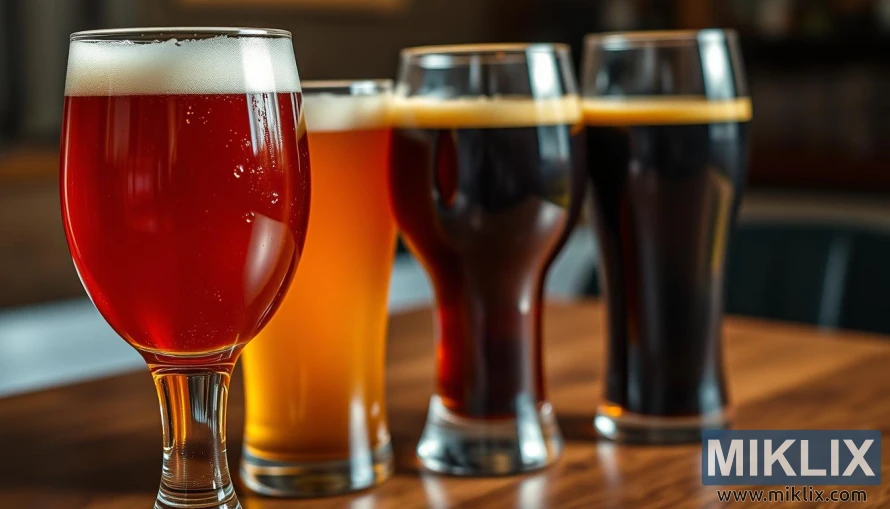Using Rye as an Adjunct in Beer Brewing
Published: July 24, 2025 at 7:35:45 AM UTC
Beer brewing has seen a significant evolution with the introduction of various grains as adjuncts. These additions enhance flavor and character. Rye, in particular, is gaining popularity for its unique contribution to beer. As an adjunct, rye is added to barley to create a more complex flavor profile. This addition can enhance the beer's experience, broaden its flavor, or increase its mouthfeel. It offers brewers a versatile ingredient for experimentation. The use of rye in beer brewing reflects a larger trend in craft beer towards innovation and diversity. Many brewers are now exploring different grains to create unique beers.

Key Takeaways
- Rye is used as an adjunct in beer brewing to enhance flavor and character.
- The addition of rye can create a more complex and interesting flavor profile.
- Craft brewers are increasingly experimenting with rye and other grains.
- Rye adds a unique dimension to beer, enriching the drinking experience.
- The use of adjuncts like rye is part of the innovation in craft beer.
Understanding Rye in Beer Making
The use of rye in beer production has ancient roots, with significant historical ties to Germany. It has been a staple in brewing, most famously in Roggenbier. This beer is known for its unique flavor and aroma.
Rye's history in brewing isn't exclusive to Germany, but its use there is well-documented. Adding rye to beer recipes introduces complexity and a spicy flavor. These traits have made it a favorite among craft brewers seeking to innovate.
In recent years, rye has become more popular as a brewing adjunct. Many brewers are experimenting with different types of rye to craft unique and delicious beers. The craft brewing movement has fueled this interest, encouraging innovation and the exploration of traditional brewing practices.
Understanding rye's role in beer making requires appreciating its historical context and its impact on flavor and aroma. As brewers continue to experiment with rye, the possibilities for new and exciting beer styles are endless.
Benefits of Adding Rye to Your Beer
Adding rye to beer brewing introduces a spicy and dry flavor dimension. This unique flavor and aroma it provides are key benefits. Rye can add a crisp, spicy, and dry character to the beer. This complements various hop and malt flavors.
The flavor and aroma of rye vary based on the type used and brewing techniques. Some brewers value rye for its ability to add complexity and depth to their beers.
The benefits of using rye in beer brewing can be summarized as follows:
- Enhances flavor complexity with a spicy and dry character
- Adds a crisp and refreshing quality to the beer
- Complements a variety of hop and malt flavors
- Contributes to a distinctive and refreshing flavor profile
By incorporating rye into your brewing recipe, you can create beers with unique characteristics. Whether brewing a rye IPA or a rye stout, rye elevates the flavor and aroma profile.

Different Forms of Rye for Brewing
Rye's versatility in brewing is showcased through its various forms, from malted to flaked rye. Each form has its own characteristics and benefits in the brewing process.
The most common form of rye is malted, which has been germinated to activate enzymes. These enzymes break down starches into fermentable sugars. This form is highly versatile and can be a significant part of the grist.
Other forms like roasted malt, rolled rye, flaked rye, and whole grain rye are also used. Roasted rye malt brings a deep, rich flavor. Flaked rye, on the other hand, contributes to a smoother, more complex character in the beer.
- Malted Rye: Provides enzymatic activity and fermentable sugars.
- Roasted Rye Malt: Adds depth and complexity with roasted flavors.
- Flaked Rye: Contributes to a smoother character and can aid in lautering.
- Whole Grain Rye: Can be used to add texture and a more robust flavor profile.
Each form of rye can create different effects in the final beer. From flavor and aroma to mouthfeel and complexity, brewers can experiment with various rye beer styles. Understanding and using these forms allows for a wide range of experimentation.
Optimal Percentages for Rye Addition
## Optimal Percentages for Rye Addition
Determining the optimal percentage of rye to add to your beer recipe is key for the desired flavor. The ideal amount can vary with the beer type and brewing techniques.
A rye concentration between 10-20% is generally recommended for most beer styles. This range lets brewers enjoy rye's unique spicy flavor and dry finish without overwhelming other ingredients.
Some brewers, like home brewers, have tried higher rye percentages, up to 50%. They aim to create unique and complex flavors. When choosing rye percentage, brewers should think about the beer style and the flavor they want to achieve.
- Low Rye Percentage (5-10%): Adds a subtle complexity and a slight spicy flavor.
- Moderate Rye Percentage (10-20%): Provides a balanced rye character, enriching the beer's complexity.
- High Rye Percentage (20-50%): Results in a pronounced rye flavor and a drier finish, ideal for more experimental brews.
Understanding the impact of different rye percentages helps brewers make informed choices. This way, they can achieve their desired beer characteristics.
Impact on Mash Chemistry
Rye's unique properties can significantly alter mash chemistry, affecting pH and viscosity. Its high β-glucan content increases wort viscosity, making the mash thicker. This can make sparging more challenging.
This viscosity change requires adjustments in the brewing process. Brewers might need to adjust mash temperature or add enzymes to break down β-glucans. Rye also impacts mash pH, which is vital for enzyme activity and beer flavor.
- Key considerations when brewing with rye include monitoring mash pH to ensure optimal enzyme activity.
- Managing viscosity through the addition of enzymes or adjusting the mash temperature.
- Understanding the impact of rye on the overall mash chemistry to make necessary adjustments.
By understanding and adjusting for the effects of rye on mash chemistry, brewers can better control the brewing process. This ensures they achieve the desired characteristics in their beer.
Equipment Considerations for Brewing with Rye
Rye brewing requires specialized equipment to handle its unique properties effectively. Unlike other grains, rye's sticky and viscous nature complicates the brewing process. This is most evident during mashing and lautering.
Working with whole-grain rye necessitates the use of a cereal cooker. This tool is essential for gelatinizing the starches. It makes them more accessible for enzymatic conversion during the mash. Achieving optimal extraction is critical to avoid starch haze or unconverted starches in the beer.
Brewers may also consider specialized mash tuns and lauter tuns for rye brewing. These are designed to tackle the grain's sticky, impenetrable mash challenges. Features like robust agitation systems in mash tuns and advanced sparging systems in lauter tuns can be game-changers.
- Specialized mash tuns with robust agitation systems can help manage the viscosity of rye mashes.
- Lauter tuns with advanced sparging systems can improve the efficiency of wort separation.
- Cereal cookers are essential for pre-gelatinizing whole-grain rye, boosting its contribution to the brew.
Choosing the right equipment for rye brewing allows for better process control and efficiency. It leads to the production of high-quality rye beers. These beers highlight the grain's distinct flavor and character.

Step-by-Step Brewing Process with Rye
The art of brewing with rye involves several critical steps to achieve a top-notch beer. The first step is to pick the right type and amount of rye. This choice is key, as rye brings its own distinct flavor to the brew.
Choosing between flaked rye, rye malt, or a mix depends on the desired taste. Flaked rye adds a spicy kick, while rye malt enhances the beer's complexity and maltiness.
After deciding on the rye, the brewing journey starts. It includes mashing, sparging, boiling, and fermentation. Mashing mixes grains with hot water to extract sugars. Rye's presence can alter mash chemistry, so pH or temperature adjustments might be necessary for optimal extraction.
- Crush the grains, including the rye, to prepare them for mashing.
- Mix the grains with hot water in the mash tun to create the mash.
- Sparge the mash with hot water to extract the sugars and create the wort.
- Boil the wort with hops to add bitterness, flavor, and aroma.
After boiling, the wort cools and goes into a fermentation tank. Yeast is added, starting fermentation. Rye beers ferment like others, but rye can sometimes slow or complicate the process.
By adhering to these guidelines and making necessary adjustments, brewers can craft a premium rye beer. This showcases the unique qualities of this versatile grain.
Popular Rye Beer Styles
Rye beers are celebrated for their spicy and complex flavors, attracting beer lovers worldwide. The use of rye in brewing has led to a wide array of tastes and methods. This diversity makes rye beers a favorite among those who enjoy exploring new flavors.
Beers like Cane and Ebel, Hop Rod Rye, and Ruthless Rye are prime examples of rye's impact. They highlight the unique taste and character rye can add to beer. Rye's versatility allows it to be used in a variety of styles, from pale ales to stouts. This makes it a go-to ingredient for brewers looking to experiment.
- Rye Pale Ale: Combines the crispness of a pale ale with the spicy flavor of rye.
- Rye IPA: Adds a complex twist to the hoppy flavor of an IPA.
- Rye Stout: Brings a dry, spicy finish to the rich flavor of a stout.
- Rye Porter: Enhances the maltiness of a porter with the distinctive character of rye.
These examples show how rye can transform different beer styles. By trying out various styles and techniques, brewers can fully harness rye's flavor. This leads to the creation of unique and delicious beers.

Managing Fermentation with Rye Additions
Rye additions can significantly impact the fermentation process, requiring brewers to adapt their techniques. The unique characteristics of rye, such as its high beta-glucan content, can affect yeast performance and fermentation dynamics.
To manage fermentation effectively when brewing with rye, brewers should consider the following tips:
- Select a yeast strain that is tolerant of the compounds found in rye, such as ale yeast strains that are known for their robustness.
- Control fermentation temperatures within a suitable range to prevent off-flavors and promote healthy yeast activity.
- Monitor fermentation progress closely, as rye can sometimes lead to slower or stuck fermentations.
Adjusting the fermentation schedule and techniques may be necessary to compensate for the effects of rye. This might include:
- Adjusting the mash temperature to optimize enzyme activity and sugar production.
- Using a step-mash or decoction mash to improve lautering and extract recovery.
- Implementing a yeast re-pitch or adjusting the yeast pitching rate to ensure adequate yeast cells for fermentation.
By understanding the impact of rye on fermentation and adapting brewing practices, brewers can successfully produce high-quality rye beers. These beers will have complex and balanced flavor profiles.
Flavor and Aroma Profiles
Brewing with rye introduces a distinct element to beer, marked by crisp, spicy, and sometimes dry flavors. The type of rye used, along with brewing techniques and ingredients, shapes the flavor and aroma profiles of rye beers.
The use of rye can lead to a range of flavor profiles. These include:
- Crisp and refreshing, with a dry finish
- Spicy, with notes of pepper or clove
- Complex, with a balance of malt and hop flavors
The aroma of rye beers can also vary. It can range from subtle hints of spice to more pronounced earthy or grainy notes. The brewing process, including mash temperature and hop addition, significantly influences the final flavor and aroma.
Common characteristics of rye beer aroma include:
- A spicy or peppery aroma
- Earthy or grainy notes
- A dry, crisp character that complements the beer's flavor
Understanding how rye impacts flavor and aroma allows brewers to create unique and complex beers. This showcases the versatility of this ingredient.
Common Challenges and Solutions
Brewers often encounter specific hurdles when working with rye, including issues with mash chemistry and equipment. One major challenge is managing the sticky nature of rye. This can lead to a high-viscosity mash.
This viscosity can cause problems with lautering and sparging. It may result in a stuck mash or reduced efficiency. To mitigate this, brewers can adjust their mash temperature and grain bill composition.
Another challenge is the risk of equipment clogging due to rye's high protein and fiber content. Regular cleaning and maintenance of brewing equipment can help alleviate this issue.
To overcome these challenges, brewers can employ several strategies, including:
- Using a step mash to improve lautering
- Adding rice hulls or other lautering aids to reduce viscosity
- Adjusting the percentage of rye in the grain bill to balance flavor and brewing complexity
By understanding these challenges and implementing effective solutions, brewers can successfully incorporate rye into their recipes. This produces unique and flavorful beers. Troubleshooting common issues and being prepared to adapt brewing techniques are key to successfully brewing with rye.
Commercial Examples of Rye Beers
Commercial rye beers are gaining popularity, with Cane and Ebel and Hop Rod Rye at the forefront. These beers highlight rye's versatility and distinct taste in brewing.
Many breweries have successfully integrated rye into their recipes. This has led to a wide variety of rye beers on the market. Some notable examples include:
- Cane and Ebel, known for its spicy and complex flavor profile.
- Hop Rod Rye, which combines the boldness of rye with hoppy notes.
- Ruthless Rye, providing a robust and full-bodied rye beer experience.
These commercial examples showcase the creativity and innovation of breweries with rye. Rye's unique contribution to these beers distinguishes them from other styles.
The success of these rye beers has inspired other breweries to explore rye in their recipes. This has contributed to the increasing popularity of rye beers in the craft brewing world.
Recipe Development Guidelines
Creating a rye beer recipe demands careful consideration of rye's distinct qualities alongside other ingredients. The first step is to pick the right type and quantity of rye. Whether using flaked rye, rye malt, or a mix, it greatly influences the beer's taste and character.
When crafting a rye beer recipe, several key factors come into play:
- Choose the right type of rye: Flaked rye, rye malt, or a combination of both can be used, depending on the desired flavor profile.
- Determine the optimal percentage of rye: The amount of rye used will affect the beer's flavor, with higher percentages producing a more pronounced rye character.
- Balance rye with other ingredients: Rye can be quite assertive, so it's essential to balance it with other grains, hops, and yeast to create a harmonious flavor profile.
- Consider the brewing process: Rye can affect mash chemistry and fermentation, so brewers may need to adjust their brewing process.
To illustrate the recipe development process, let's consider a sample homebrew rye recipe. A basic rye beer recipe might include:
- 5 lbs pale malt
- 1 lb flaked rye
- 1 lb specialty malt (e.g., Munich or Victory)
- Hops (e.g., Cascade or Chinook)
- Yeast (e.g., ale yeast or a yeast strain suitable for rye beers)
This recipe can be a starting point, and brewers can tweak the ingredients and proportions to match their taste preferences. The goal is to experiment and find the perfect balance of flavors for a unique and delicious rye beer.
Conclusion
Rye is a versatile grain that adds a distinctive flavor and character to beer, making it a valuable adjunct in brewing.
By understanding the benefits and challenges of brewing with rye, brewers can craft high-quality beers that showcase its unique characteristics.
This summary provides a detailed look at using rye in beer brewing. It covers its benefits, the brewing process, and its ability to create complex and engaging beers.
Whether you're a home brewer or a commercial brewer, incorporating rye into your next beer recipe can lead to exciting new flavors and styles.
Further Reading
If you enjoyed this post, you may also like these suggestions:
- Using Honey as an Adjunct in Beer Brewing
- Using Maize (Corn) as an Adjunct in Beer Brewing
- Using Roasted Barley in Beer Brewing
